
Washington officials told a Senate panel that cap-and-trade auctions could raise almost $1.5 billion through fiscal 2024 and reiterated their contention that a new low-carbon fuel standard will raise gas taxes by about one penny per gallon.
Ecology department officials briefed the Senate Transportation Committee late Monday on the cap-and-trade law and its low-carbon fuel standard, both of which took effect Jan. 1.
Luke Martland, a cap-and-trade official for the department, said the revenue estimates are preliminary and liable to change. “It’s key to remember that we don’t know the future,” he said.
Washington has the nation’s second cap-and-trade system for industrial carbon emissions, following California. Much of Washington’s calculations are based on what it is observing in California.
Later this legislative session, the state Senate and House plan to allocate revenue from the state’s first cap-and-trade auction, set for Feb. 28.
Martland said the department estimates $484 million in cap-and-trade revenue for fiscal 2023 (July 1, 2023 to June 30, 2024) and $957 million in fiscal 2024.
Martland said the revenue from the auctions is expected to shrink over time as the number of emission allowances is reduced. He also said the calculations are less reliable as they are projected farther into the future. The department estimates $901 million in revenue for FY 2025, $730 million in FY 2026 and $592 million in FY 2027.
Emitting companies would bid on the allowances, which would be made available in batches of 1,000. The first auction will cover 6.185 million allowances, with a minimum allowed bid of $22.20 per allowance. The highest bidder would get first crack at the limited number of allowances, the second-highest bidder would get second crack, and so on. The auction ends when the last of the designated allowances is bid upon. Then all successful bidders will pay the same price per allowance as the lowest successful bid.
Sen. Curtis King, the transportation committee’s ranking Republican, questioned why the state’s latest carbon emission totals date from 2019, when the legislature is planning for 2023. He also noted that King County (which includes Seattle) has 2020 carbon emissions figures available.
Martland replied that the ecology department does not have enough staff for the labor-intensive task of obtaining more current figures. He added that the department is seeking money for the 2023-2025 budget biennium to add staff to speed up this work.
Potential recipients of cap-and-trade revenue are planting a massive number of trees along Washington’s rivers and streams to provide shade for migrating salmon. When water temperatures rise above the low 70s, the health of the fish is threatened. Another potential recipient is a proposed “tree bank” program. The proposal would address trees being cut down by developers and provide designated areas where replacement trees could be planted.
Republicans want to use some cap-and-trade money to create an Office of Puget Sound Water Quality to provide help to municipal sewage treatment plants to decrease the amount of nitrogen-laden nutrients dumped into the sound. These nutrients starve fish of the oxygen they need.
Impact of Fuels Standard
Also Monday, King challenged a statement by Joel Creswell, the ecology department’s climate policy section manager, that the new low-carbon fuel standards would raise Washington’s gas tax by one penny per gallon. King said he has heard estimates of 47 cents to 50 cents per gallon.
Creswell said he has heard the same higher estimates, but they were anecdotal and not backed by solid studies. He said the state had hired a consultant to study the matter, which led to the one-penny estimate. “We believe the information we have is credible,” Creswell said.
Washington’s low-carbon fuel standards require that carbon emissions from gasoline and diesel fuel sold in Washington be cut by 10% below 2017 levels by 2028 and by 20% by 2035. The bill excludes from the goals fuel that is exported out of state and fuel used by vessels, railroad locomotives and aircraft. The goals apply to overall vehicle emissions in the state and not to individual types of fuels. Northwestern Washington has five oil refineries.


